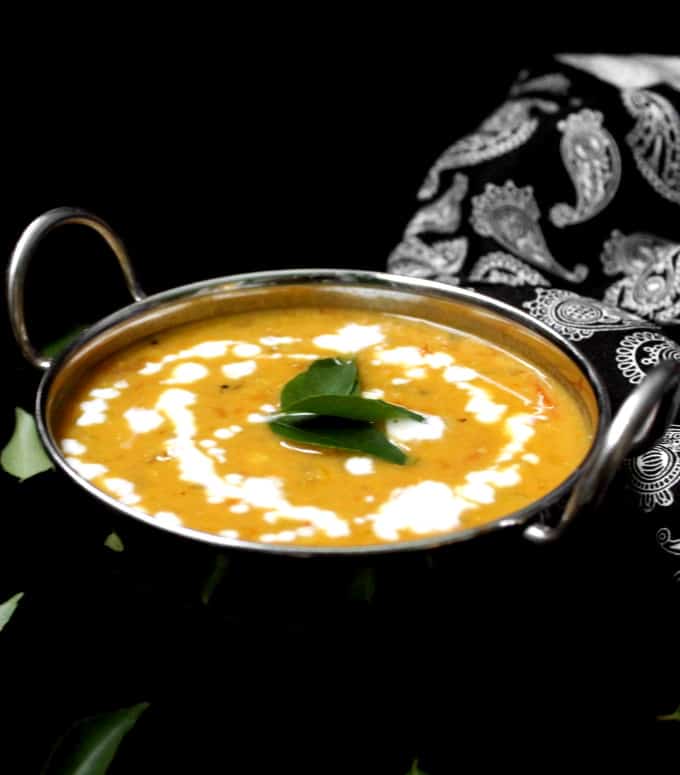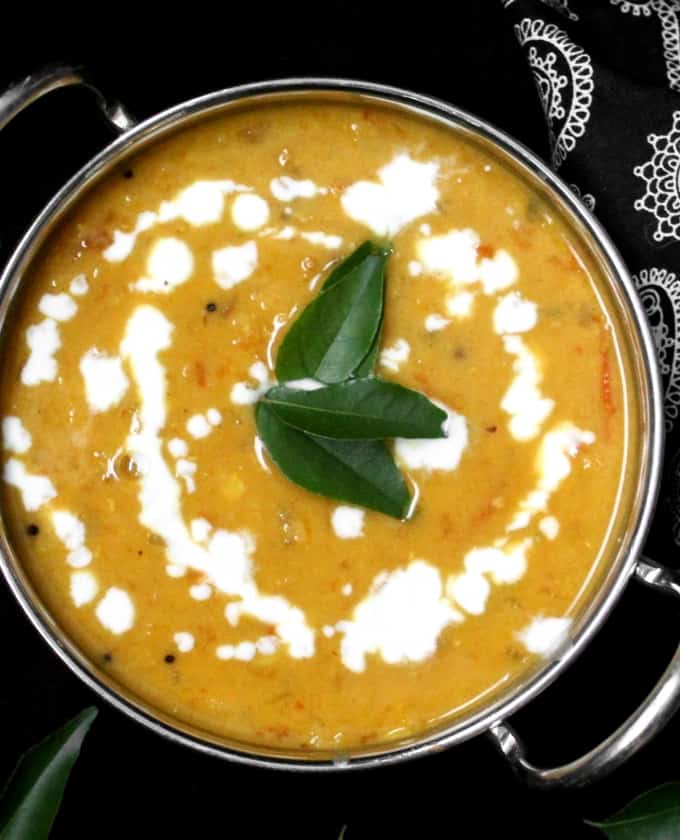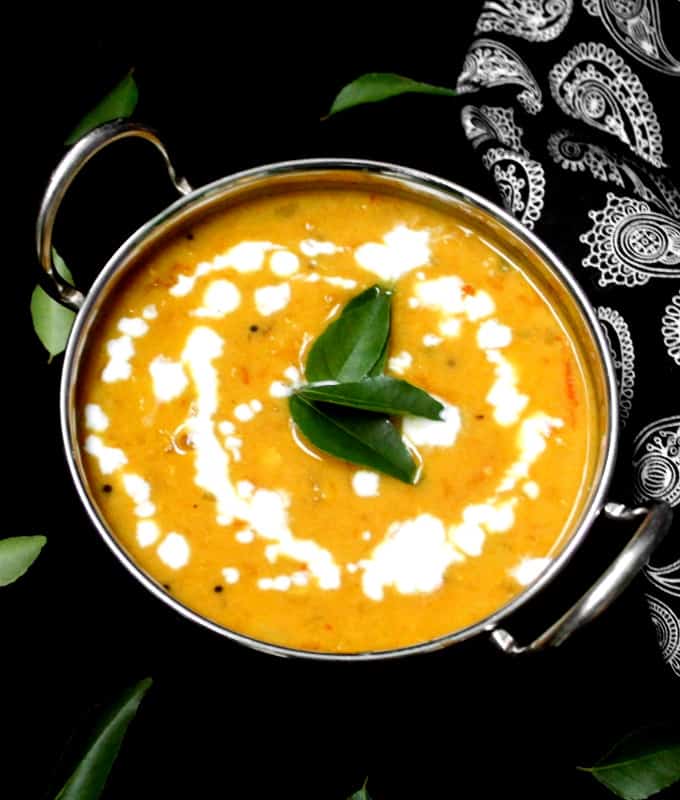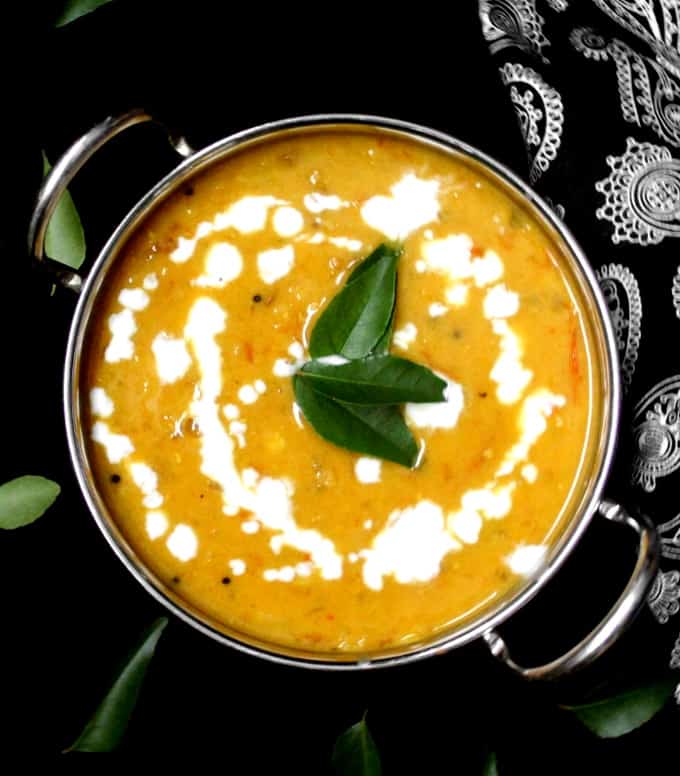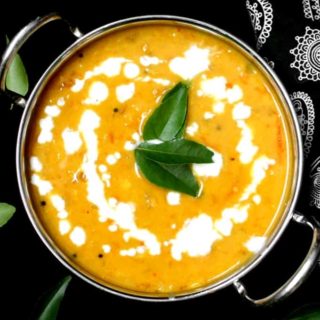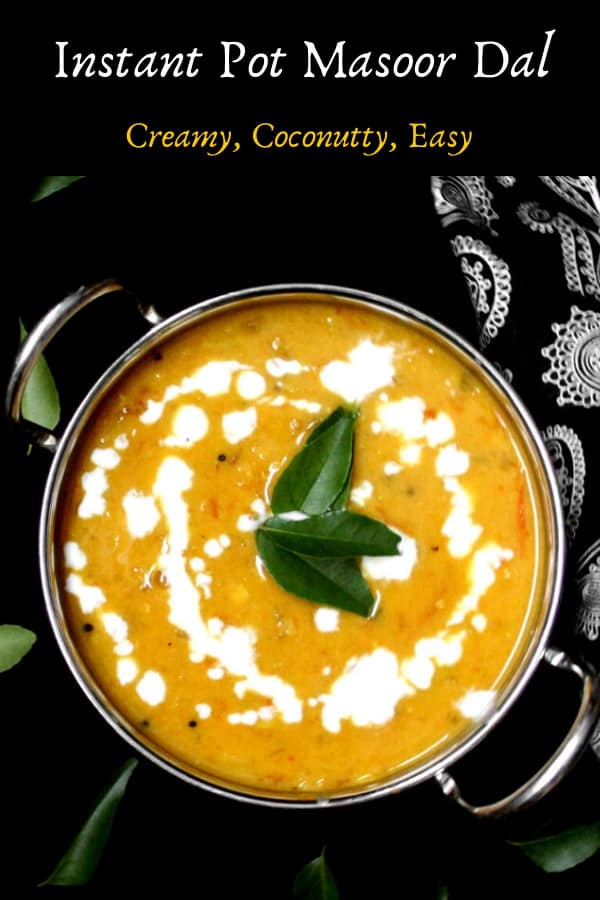You might also like these recipes for Indian dals made in the Instant Pot, including Instant Pot vegan dal makhani and Sindhi sai bhaji. Making dal in an Instant Pot is a no-brainer because although a good Indian dal (also spelled “dahl"or “dhal”) is by no means a difficult or time-consuming dish to make, an Instant Pot just makes the entire process so much easier. Even better, all of the cooking can happen in one pot, making cleanup a breeze. In our Indian-food-loving home, dal is on the menu at least twice a week, and we especially love recipes like this simple but delicious Indian dal and this easy but flamboyant Dal Tadka. But making dal – the proper way – can be a bit of a mess-making affair. You need to boil the dal separately, preferably in a pressure cooker. Then you need to saute the onions, ginger, garlic, veggies, or whatever you’re using in your recipe in another pot before you add your dal to it. And finally, you need a little saucepan for the tadka, which is the tempering of oil and spices that finishes off any Indian dish, giving it that defining flair it cannot do without. By now your overstressed dishwasher’s ready to break down. I’ll be honest – I cheat. When in a rush, I’ll do the tadka first in the big saucepan and then add in the rest of the ingredients and the dal. And that can be fine in most cases, so long as you have cooked dal on hand and your cooking time is going to be short. But yes, you do have to cook that dal first. In a pressure cooker or in a separate pot on the stovetop. There probably are cooks who will say, hey, wait, we just do everything in one pot: the tadka, the onions, the dal, etc., and it tastes just fine. To which I would say, sorry, but in that case you probably don’t know what a dal should really taste like. Here’s why. Most lentils take a while to cook to the mushy tenderness you need in a dal, which could range from 20 minutes at best to even an hour. And while those lentils are cooking, the rest of the tadka ingredients you so optimistically already added to the pot are overcooking and losing all of their flavor and texture. So in the end, the dish you will serve will likely look – and taste – like a bland, dull, gloppy mess rather than that dreamy dal you were going for. The Instant Pot, however, is an exception. Perhaps because the dal cooks quite so quickly in it, or perhaps because its just a magical little appliance. Who knows? 😉
What is masoor dal?
Masoor dal are gorgeous, coral-red lentils that you can find at nearly any grocery store here in the United States (no trips to the ethnic market required). But if you do wander into an Indian grocery store, you’ll be delighted – and probably a little confused – to come across different versions of masoor, including:
The whole masoor or sabut masoor, which is simply the unsplit version of the lentil with its brown skin still on. I really love whole masoor – it cooks up with a completely different, far nuttier taste than the split version does, and it remains whole even when really soft, giving your dal a really lovely look (try this Whole Masoor Dal, one of my favorite weeknight dals). Masoor matki, which is a smaller version of the whole masoor and on the packet usually goes by the cute sobriquet of “whole baby masoor lentils”. There’s even a green masoor, which is the whole bean but with a green skin, and a yellow one. Masoor gota, which is the whole bean with the brown skin removed. Finally, you have the most predominantly used kind of masoor: masoor dal, or red lentils. These are the skinned, split lentils and these are what we’ll be using today.
Incredibly, despite all this variety, masoor is not really a popular lentil in India. Sure, we Indians have invented a bazillion kinds of dal and we make one with masoor every now and then, so it’s not like we ignore it altogether. But it is also true that Indian cooks have, for some mysterious reason, failed to treat masoor with the love and respect we reserve for tuvar dal (split pigeon peas), urad dal (black lentil dal), moong dal (mung dal) and chana dal (bengal gram dal). The reason could be that masoor dal tends to be more neutral tasting – and is therefore considered bland by some – compared to other dals, which have stronger personalities. But in my book that makes it a winner because it absorbs all of those tadka and other flavors so much better. That, and the fact that masoor cooks up much faster than almost any other lentil around. Check to get new recipe updates by email.
Yep. Weeknight dinner alert. And because it breaks down so easily, it is a really great dal to use when you want a super creamy dal. Like this Instant Pot Masoor Dal I have for you today.
Ingredients:
Vegetable oil Black mustard seeds Onions Curry leaves (optional) Ginger Garlic Tomatoes Coriander powder Turmeric Red pepper flakes (or red chili peppers) Masoor dal or red lentil dal (the split kind) Coconut milk Cilantro for garnish (optional) Lemon juice (optional)
How to make Instant Pot masoor dal
This is an incredibly flavorful dal, with a base of onions, garlic, ginger and tomatoes. The coconut milk makes it creamy and marries all of the spices and herbs so beautifully, your tastebuds will do a tango. Better still, because it’s made in the Instant Pot, you can do it all in one pot with under 10 minutes of hands-on time, and you can have dinner on the table in 30 minutes. You don’t have to presoak the dal, and all you need to do is quickly pick over it for anything that doesn’t belong in there. It’s also a good idea to rinse the dal quickly in a strainer, just to get rid of any dust or other impurities that may have clung to it during its journey from a farm to you, but you don’t have to do it.
Tips
Start out by sauteing the ingredients in the Instant Pot set to the saute function, so it’s best to have all of your ingredients chopped and ready. That way you can get everything into the IP in quick succession. Chop your onions and dice your tomatoes fine. You want the dal to be creamy, and when the veggies are finely diced and thoroughly cooked, they will simply melt away into your dal. The curry leaves are optional because I know everyone can’t easily find them. I love using curry leaves with most recipes that include coconut – it’s a south Indian thing, and these two flavors are marvelous together. You can also sub the curry leaves with 2 tablespoon cilantro for great flavor. I prefer to use the canned coconut milk over the kind that comes in a carton because I find the flavor more true to fresh coconut milk. If you can use freshly extracted coconut milk, good for you! Finally, for those of you who have my basic tomato onion masala sauce on hand, I have good news: you can make this recipe even faster using the sauce. I’ll include directions in the recipe notes.
More tasty vegan dal recipes
Spicy Urad Dal (Black Lentil Dal) Black Eyed Peas Dal with Cilantro and Mint Instant Pot Vegan Dal Makhani One Pot Garlicky Spinach Dal Creamy Moong Dal
Recipe card

